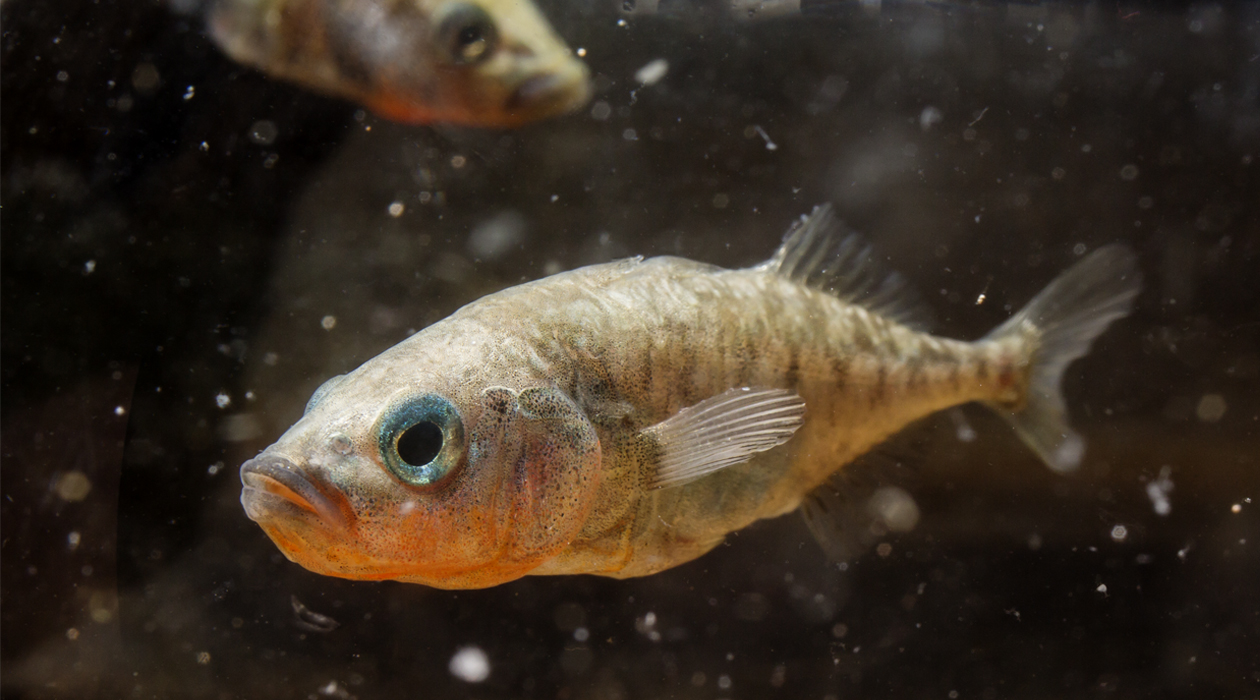The big why: Alison Bell seeks answers to fundamental questions about individual behavior

Three-spined sticklebacks interacting as part of study done by Prof. Alison Bell / L. Brian Stauffer
For evolution, ecology and behavior professor Alison Bell (GNDP leader), asking big questions seems to be a lifelong habit.
As an undergraduate studying the history and philosophy of science at the University of Chicago, many of those questions were epistemological: How do we know what we know? How is knowledge distorted by our societal norms, prejudices, and blind spots?
She was also, on a more personal level, asking if she wanted to become a scientist.
As a child growing up in a rural area of northern California, she had always been interested in animals. Her parents thought she might become a vet, but her high school AP Biology textbook suggested a different path.
“Usually the last chapter of a biology textbook is where all the really good stuff is, that has to do with evolution and how behavior evolves,” Bell said. “I remember finishing that class and thinking that stuff at the end was the juiciest stuff. That was what I wanted to study.
“When I got to college I snuck into an animal behavior class that I didn’t have the prerequisites for. And I promised myself that if I got at least an A- I would talk to the instructor at the end of the class.”
She got the grade, she talked to professor Lynne Houck, and the “amazing mentorship” of Houck and other faculty members helped Bell make the leap to studying and practicing science.
Today she leads a research team that seeks answers to a fundamental question: Why do individuals behave differently from one another?
“Think about your own pets. They have a distinctiveness to their behavior. They have an element of uniqueness that they carry with them through situations and over time,” Bell said. “Why is there this variation? From an evolutionary point of view, we think of natural selection as being a force that sort of removes that individual variation. So what keeps that variation around?”
Bell’s team pursues answers to these big questions by closely studying the relatively small stickleback fish. Three-spined stickleback, which reach a max of about 4 inches in length, are widely distributed in both fresh and marine waters in the Northern Hemisphere. The species has long been of interest to animal behaviorists because of what Bell calls on her website their “rich behavioral repertoire,” including individual variation in behaviors that can also be found in human beings, such as risk taking and aggressiveness.
“They do everything, and they do it in such interesting ways,” she said. “They are a way of condensing a particular problem into a very tractable system.”
For example, most stickleback males are responsible for caring for offspring–tending and defending the nests where females spawn and watching out for their vulnerable newly hatched young. But there are interesting variations and complexities, which Bell’s lab explore. Some male individuals provide more care than others–why? Bell’s lab has found that one key parental behavior, fanning the nest, is highly heritable–what mechanism transfers this behavior from parent to offspring? The so-called “white sticklebacks” in Nova Scotia do not provide care for their young–why?
When Bell started her lab, the stickleback genome had just recently been sequenced, and she was excited about opportunities to look beyond a single gene to the entire genome, to measure gene expression rather than just a static DNA sequence. “Technology opens up new avenues in what you can do,” she said. As the Bell lab employed new methods to investigate behavioral variation at the molecular level, they found that the stickleback’s genome reacts to environmental factors, such as opportunities for courtship and risk of predation.
In recognition of this type of pioneering work, Bell was recently awarded a 2024 Guggenheim Fellowship. As a Guggenheim Fellow, she will work toward developing a conceptual framework that integrates neural and gene regulatory networks to offer new insights into individual behavior differences.
It’s not just the behavior of fish, cats, or dogs that Bell and her collaborators hope to better understand. As leader of the recently launched Bill and Julie Kellner Center for Neurogenomics, Behavior and Society at the Carl R. Woese Institute for Genomic Biology, Bell also hopes to shed light on human behavior.
The Kellner Center brings together researchers from the Carl R. Woese Institute for Genomic Biology, the Center for Social & Behavioral Science, and the School of Social Work with the goal of better informing practitioners and policy makers as they address societal challenges. Julie Kellner (BA, ‘73, political science) said mental illness is a major focus, with the hope that neurogenomic discoveries could one day help develop therapies or medication.
“The gift from the Kellners will allow us to pursue high-risk, high-payoff projects … and will facilitate building interdisciplinary collaborations that are needed for contemporary studies of genes, brain, and behavior from both scientific and societal perspectives,” Bell said in a March 2024 announcement about the new center.
“Part of the goal is to better communicate what we’re learning and its societal implications,” she added recently. “An overly simplistic deterministic view in which a single gene is responsible for a behavior is not accurate. It’s more complicated than that.
“If you really want to understand behavior, you have to study organisms in their natural environments and embrace the complexity.”
